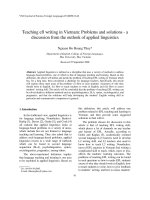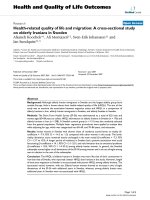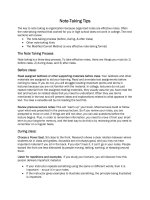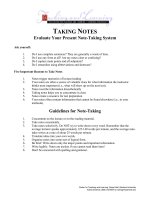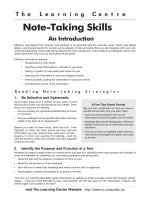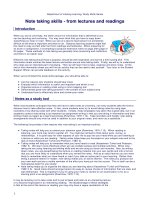Some English stress mistakes and solutions - A phonetic experimental Research on Vietnamese Students
Bạn đang xem bản rút gọn của tài liệu. Xem và tải ngay bản đầy đủ của tài liệu tại đây (1.58 MB, 11 trang )
International Journal of Language and Linguistics
2017; 5(2): 39-49
/>doi: 10.11648/j.ijll.20170502.13
ISSN: 2330-0205 (Print); ISSN: 2330-0221 (Online)
Some English Stress Mistakes and Solutions - A Phonetic
Experimental Research on Vietnamese Students
Tran Thi Thanh Dieu
Faculty of English Linguistics and Literature, University of Social Sciences and Humanities, Viet Nam National University, Ho Chí Minh City,
Vietnam
Email address:
,
To cite this article:
Tran Thi Thanh Dieu. Some English Stress Mistakes and Solutions - A Phonetic Experimental Research on Vietnamese Students. International
Journal of Language and Linguistics. Vol. 5, No. 2, 2017, pp. 39-49. doi: 10.11648/j.ijll.20170502.13
Received: February 26, 2017; Accepted: March 10, 2017; Published: March 27, 2017
Abstract: The combination of phonological knowledge with rhythm and English stress rules is one of the solutions for English
stress problems facing Vietnamese students. From the phonetic experiment, some types of stress mistakes made by Vietnamese
students were discovered. The hypothesis is that the English Rhythmic patterns and English stress rules will help students to
solve their stress problems. However, the English stress rules are so complicated. Therefore, based on the main rhythmic pattern,
the key for stress rules has been raised to simplify the way to recognize stressed syllables. The final target is to help Vietnamese
students identify English words through different ways of stress placement in order to increase their pronunciation ability as well
as catching the main idea in the conversation to improve their communicative skill in English.
Keywords: English Rhythmic Pattern, Complex Rhyme, Heavy Syllable, English Stress Rules, Phonetic Experiment
1. Introduction
No one can deny that every language in the world has its
own characteristic speech rhythm. English tends to be a
stress-timed language with rhythmic patterns based on a fairly
regular recurrence of stressed syllables [3]. However,
Vietnamese tends to give equal weight to each syllable
[4, 29, 30]. As a result, many students often use the
Vietnamese rhythmic pattern when speaking English. In
addition, Vietnamese language has mono-syllabic words while
English words are multi-syllabic. Therefore, they are the main
reasons leading to stress problems facing Vietnamese
students.
To solve this problem, it is important for students to know
the different rhythmic patterns between Vietnamese and
English. Moreover, the English stress rules are so complicated
that it is not easy for Vietnamese students to recognizer stress
syllables in English multi-syllabic words. Therefore, the paper
aim to simplify the English stress rules mainly based on the
English rhythmic characteristics and types of English stress
mistakes recognized through phonetic experiment made by
Vietnamese students.
2. Methodology
The research was conducted for twenty–four weeks from
January 2012 to June 2012 with six weeks for preparation and
choosing population, twelve weeks for phonetic experiment,
and the last six weeks for data analysis. The method used in
the research is the comparative strategy based on the prosodic
analysis of Rhythmic patterns between English and
Vietnamese, as well as the combination of quantitative
approach and phonetic experimental approach to find out
students’ stress mistakes and solutions.
The word samples were recorded from the ‘Oxford
Advanced Learner Dictionary’ ‘Cambridge Advanced Learner
Dictionary’ and ‘Multi-Dictionary version 9.0 HuyBiên 2008’,
called standard pronunciation (Cáchphátâmchuẩn = CPAC) or
RP (Received pronunciation) and from the population
(students), called investigating samples (Mẫukhảosát = MKS)
or T (Token). The data was analyzed and illustrated by
SPEECH ANALYZER (Copyright © 1996-2007 by SIL
International) and PRAAT 5.05.12. (copyright @ 1992-2008
by Paul Boersma and David Weenink).
40
Tran Thi Thanh Dieu:
Some English Stress Mistakes and Solutions - A Phonetic Experimental
Research on Vietnamese Students
3. Data Analysis and Finding
3.1. Comparison Between English and Vietnamese
Rhythmic Patterns
“English is a Stress-timed language, with the rhythmic
pattern based on the regular repetition of the stressed syllables.
Whereas, Vietnamese tends to have the equal syllable to form
the Rhythmic pattern of the Syllable-timed language, with the
syllables having the equal intensity” [[3]]. Therefore in the
paper “A case study of solutions to some stress mistakes made
by Vietnamese students - a phonetic experimental research”
by Dr. Tran Thi Thanh Dieu, a table of comparison between
the English and Vietnamese rhythmic patterns has been
summarized as follows [[6]].
Table 1. Comparison of the English and Vietnamese Rhythmic Patterns.
Type of
language
Pattern
Meaning of the
abreviation
ENGLISH RHYTHMIC
PATTERN
Stress-timed language, with
the rhythmic pattern based
on the regular repetition of
the stressed syllables
{F = [S W]}
F = Foot
S = strong W = weak
VIETNAMESE
RHYTHMIC PATTERN
Syllable-timed language,
with the syllables having
the equal intensity,
{N = [A]} = {R ==[S]}
N = nhịp (= Rhythm)
A = âm tiết (= syllable)
The foundation of the English rhythmic pattern is the existence
of the 2 types of syllable: heavy and light syllable. A light syllable
contains only a short vowel in the rhyme, with no coda, as in the
first syllable of the word “about” because onsets are entirely
irrelevant to the calculation of syllable weight [[18]]. If a syllable
has a complex rhyme, then it is heavy; and complexity of rhyme
can be achieved in two different ways. First, a heavy syllable may
have a short vowel, but one or more coda consonants, as in the
word “bet, best”. Second, it may have a branching nucleus,
consisting of a long vowel or diphthong; such a syllable will be
heavy whether it also has a bled coda, as the second syllable of
the word [chor ale] and as it put by the Cambridge advance
learner dictionary – third edition “when a word or syllable is
pronounced with greater force than other words in the same
sentence or other syllables in the same word, it is stressed”, as
well as Fry (1955, 1958)’s identified the intensity over the
syllable as a possible acoustic correlate of stress differences.
3.2. Phonetic Experiment for Mistakes Recognization and
Solutions
3.2.1. Phonetic Experiment Proving the Mistakes on English
Word Stress Made by Vietnamese Students
A spectrogram as the one below is created by displaying all
of the spectra computed from the speech waveform together.
The vertical axis in a spectrogram represents frequency, with 0
Hz at the bottom. The lines visible in the spectrogram on this
page each represent 1000 Hz along the frequency axis, so that
the spectrogram contains 8000 Hz in total. All of the spectra
computed by the Fourier transform are displayed parallel to
this vertical or y-axis. The horizontal axis represents time; as
we move right along the x-axis we shift forward in time,
traversing one spectrum after another. Spectrograms are
normally computed and kept in computer memory as a
two-dimensional array of acoustic energy values. For a given
spectrogram S, the strength of a given frequency component f
at a given time t in the speech signal is represented by the
darkness or color of the corresponding point S(t,f). Therefore,
RP = CPAC (Cáchphátâmchuẩn: received pronunciation
/standard pronunciation) and IS = MKS (Mẫukhảosát: token/
investigated sample) of many words of all types were recorded
and investigated by phonetic experiment providing the result,
in which the word [chorale] has been chosen for illustration as
the following spectrogram figures.
Figure 1. Spectrogram of the Pitch and Intensity comparison between RP and IS.
International Journal of Language and Linguistics 2017; 5(2): 39-49
Table 2. Comparison of the Intensity and Pitch between RP and IS.
MAXIMUM NUMBER
SYLLABLE 1
INTENSITY
SYLLABLE 2
SYLLABLE 1
PITCH
SYLLABLE 2
RP
60.66 dB
72.60 dB
IS
66.24 dB
67.05 dB
183.7 Hz
107 Hz
As it put by the Cambridge advance learner dictionary –
third edition “when a word or syllable is pronounced with
greater force than other words in other syllables in the same
word, it is stressed”, as well as Fry (1955, 1958)’s identified
the intensity over the syllable as a possible acoustic correlate
of stress differences, according to the number in the table and
the spectrogram figures above, the intensity of RP = CPAC at
the first syllable peak is 60.6dB and at the second syllable
peak is 72.60 dB, therefore, we can have the conclusion that
RP pronounced with a greater energy at the second syllable
than at the second syllable (72.60 dB - 60.66 dB = 12.06dB)
and made the English rhythm pattern as {F = [S W]}. Whereas
the intensity of IS = MKS at the first syllable peak is 66.24 dB
41
and at the second syllable peak is 67.05 dB, nearly the same
intensity at the peak of the stressed and un stressed syllable
(67.05 dB - 66.24 dB = 0.81dB), which is a serious mistake
caused by the influence of Vietnamese mother tongue, called
interfering mistake in language with the Vietnamese rhythmic
pattern as {N = [A]}. In addition, the pitch can’t be used as the
cue identifying stress syllable but just shows the accent type of
the speakers.
To find out the types of English stress mistake made by
Vietnamese students, 12 groups of IS from the Northern,
Central and Southern of Vietnam have been recorded their
pronunciation of the all kinds of English words, as follows.
Simple words: multi-syllabic words without affix of
Noun, Adjective, Verb.
Complex words: multi-syllabic words with affix.
Compound words: with 2 roots.
The result of the disyllabic word [chorale] pronounced by
12 groups of IS is used to illustrated the 3 types of English
stress mistake made by Vietnamese students.
Table 3. Intensity and Pitch mean of RP and IS in the phonetic experiment.
No
Mistake-type Group
CPAC/ RP
1
T_9
2
T/MKS_12
3
T_7
4
T_5
5
T_10
6
T_1
7
T_8
8
T_6
9
T_2
10
T_3
11
T_4
12
T_11
Intensity mean
Syllable 1
62.90 dB
66.51 dB
69.13 dB
62.14 dB
62.21 dB
66.22 dB
75.11 dB
72.01 dB
64.03 dB
67.11 dB
61.22 dB
65.04 dB
59.21 dB
Syllable 2
72.60 dB
67.06 dB
70.03 dB
65.52 dB
65.25 dB
56.02 dB
60.01 dB
69.28 dB
62.04 dB
65.55 dB
67.88 dB
73.05 dB
68.82 dB
Difference
9.70 dB
0.55 dB
0.9 dB
3.38 dB
3.04 dB
-10.2 dB
-15.1 dB
-2.73 dB
-1.99 dB
-1.56 dB
6.66 dB
8.01 dB
9.61 dB
Mistake-type and the number of
IS in every group/ 100
EXACT
A
A
33.33%
A
A
B
16.6 6%
B
AB
AB
25%
AB
Adapt 50 -69% RP
16.6 6%
Adapt 70 -90% RP
8.33% -
Figure 2. Comparison between RP Intensity and intensity difference among 12 TOKEN groups.
Pitch Difference
mean
107 Hz
183.7 Hz
189.4 Hz
176.5 Hz
123.5 Hz
122.2 Hz
163.1 Hz
103.6 Hz
199 Hz
163.2 Hz
122.7 Hz
192.4 Hz
111.3 Hz
42
Tran Thi Thanh Dieu:
Some English Stress Mistakes and Solutions - A Phonetic Experimental
Research on Vietnamese Students
3.2.2. Types of English Stress Mistake
From the phonetic experiment above, three types of English
stress mistakes have been recognized
Type 1: Rhythmic error (A)
Right stress placement but nearly the same force for the two
syllables, not adapt the Rhythmic Pattern {F = [S W]}.
The two IS (MKS) adapted 50 -69% RP (CPAC), equal to
16.66% since the intensity difference (ID) between the 2
syllable peaks of IS_3 = 67.88 dB – 61.22 dB = 6.66 dB and ID
between the 2 syllable of IS_4 = 73.05 dB – 65.04 dB = 8.01 dB.
Therefore, there was no mistake of stress placement. However,
this intensity difference can not lead to one strong syllable and
one weak syllable of the Rhythmic pattern {F = [S W]}.
Therefore, this is the illustration for the Rhythmic error (A).
ĐỐI CHIẾU HIỆU SỐ CƯỜNG ĐỘ 2 ĐINH ẨM TIẾT GIỮA CPAC VÀ MKS 3, 4
80
70
60
dB
50
CPAC
MKS_3
MKS_4
40
30
20
10
0
1
2
3
4
5
sec
Figure 3. The intensity difference between the 2 syllable peaks of the word [chorale] between RP and IS_3,4.
Type 2: Wrong placement of stress (B)
Gaining the percentage 16.66% is the two investigated
samples having the intensity difference between the 2 syllable
peaks from 10p to adapt the Rhythmic pattern {F = [S W]}.
However, the intensity difference between the two syllable
peaks of IS_1 = 60.01 dB - 75.11 dB = - 15.1dB and between
the two syllable peaks of IS_10 = 56.02 dB – 66,22 dB = - 10.2
dB, to illustrate that the two investigated samples place stress
on the 1st syllable to make the stress placement mistake (B).
ĐỐI CHIẾU HIỆU SỐ CƯỜNG ĐỘ 2 ĐINH ẨM TIẾT GIỮA CPAC VÀ MKS 1, 10
80
70
60
dB
50
CPAC
MKS_10
MKS_1
40
30
20
10
0
1
2
3
4
5
sec
Figure 4. The intensity difference between the 2 syllable peaks of the word [chor ale] between RP and IS_1,10.
International Journal of Language and Linguistics 2017; 5(2): 39-49
Type 3: The combination of type 1 and type 2: (A + B)
Rhythmic error (A) and Wrong placement of stress (B).
One more mistake type is the combination of the Rhythmic
error (A) and the wrong placement of stress (B), having 25%,
since the intensity difference between the two syllable peaks
of IS_8 = 69.28 dB - 72.01 dB = -2.73 dB, IS_6 = 62.04 dB 64.03 dB =, -1.99 dB HSCĐ and T_2 = 65.55 dB - 67.11 dB =-
43
1.56 dB to illustrate the wrong placement of stress while
placing stress at the 1st syllable. Moreover, the intensity
differences <3, showing the unablility of adapting the
Rhythmic Pattern {F = [S W]}, to compare with the intensity
difference between the two syllable peak of RP = = 72.60 dB 62.90 dB = 9.70 dB > 5.
Figure 5. The intensity difference between the 2 syllable peaks of the word [chorale] between RP and IS_2,6,8.
3.2.3. Solution
Rhythm is so important to language with multi-syllabic
words that children have to learn the rhythm of their L1
very early in life [[12]]. By the time they reach the age of
one, that rhythm is deeply familiar to them, and they will
unconsciously apply it to any L2 that they learn (Aoyama et
al. 2007). Since English learners will be predisposed to use
the rhythm of their L1, it is highly important that they make
consciously aware of the English system of rhythm. The
basic unit of English rhythm is the syllable. A syllable is
most simply explained as something with a vowel sound at
its center. And while the number of syllables in a word is
usually obvious to a native speaker of English, learners
being accustomed to different phonological rules may not
hear the syllable divisions in the same way. Since this
seriously affects both intelligibility and listening
comprehension, time must be spent training students’ ears
to notice the number of syllables in the words they learn.
Precisely, Vietnamese rhythmic pattern does not have the
differences in intensity between stressed and unstressed
syllables; on the contrary, English rhythmic pattern has
differences in intensity (of course also in pitch and vowel
duration). As a result, to be affected by this mother-tongue
characteristics, Vietnamese students are not aware of the
importance of syllable weight, shown through intensity, the
main cue to identify English word stress, which decide the
ability to catch the accurate information based on the main
syllable of a word, which is not only the stressed syllable
but also the tonic syllable in a tone unit. Therefore, teachers
should spend more time training students how to count the
number of syllable in a word, identify the syllable weight
(strong syllable/ heavy syllable = stressed syllable and
weak syllable/ light syllable = unstressed syllable) to be
able to follow the English rhythmic pattern. Therefore,
from the conclusion above, the English stress rules for
English multi-syllabic words, are systemized, as follows
[[19]].
44
Tran Thi Thanh Dieu:
Some English Stress Mistakes and Solutions - A Phonetic Experimental
Research on Vietnamese Students
International Journal of Language and Linguistics 2017; 5(2): 39-49
45
46
Tran Thi Thanh Dieu:
Some English Stress Mistakes and Solutions - A Phonetic Experimental
Research on Vietnamese Students
International Journal of Language and Linguistics 2017; 5(2): 39-49
47
Figure 6. English stress rules.
From the table of complicated stress rules above, a brief
summary of key points for recognizing the places of stress in
English words has been consolidated based on rhythm, melody,
word types (simple, compound, complex), word class (N, V,
Adj), and the number of syllable with or without affix, as well
as syllable structure based on the Rhythmic patterns [[18]]. The
foundation of English rhythmic patterns is the existence of the 2
types of syllables: light syllable and heavy syllable, called
Trochee: Trochee: Trochaic foot with 1 long syllable (= heavy
syllable = strong syllable = stressed syllable) and 1 short
syllable (= light syllable = unstressed syllable). Strong syllable
is a syllable with initial consonant and a complicated rhyme
which consists of final consonant and a short vowel or long
vowel or a diphthong as nuclei [[18], p. 125]. On the contrary, a
light syllable contains a vowel in the rhyme, with or without
onset but no coda, as the first syllable in the word report, about
[[18], p. 85].
Therefore, based on the distinction between heavy syllable
and light syllable, word class, and the number of syllable with
or without affix, as well as syllable structure based on the
Rhythmic patterns, the characteristics of stressed and unstressed
syllable have been simply systemized as follows: [[19], p. 119 –
124].
The main characteristics of the unstressed syllable:
Syllable containing schwa or short vowel or diphthong
/ ∪/, ending with not more than 1 consonant.
The main characteristics of the stressed syllable: the
syllable containing long vowel or diphthong or ending
with more than 1 consonant.
Especially, no initial syllable in a verb and no final
syllable in a noun, as well as no prefix are stressed.
(i). Simple Words: Multi-syllabic Words Without Affix
(a). Simple disyllabic words: Syllable containing long vowel
or diphthong or ending with more than 1 consonant is stressed.
Ex: photo [’f∪t∪], chorale [k ‘r≙:l], comfort [‘k mft].
(b). Simple trisyllabic words, with some special points
Trisyllabic verb: No initial syllable is stressed. Therefore,
syllable containing long vowel or diphthong or ending
with more than 1 consonant is stressed. Ex: entertain
/[ent ’tein].
Trisyllabicnoun: No final syllable is stressed. Therefore,
the syllable containing long vowel or diphthong orending
with more than 1 consonant is stressed. Ex: character
[‘k∵r∩kt], mimosa [m∩’m∪s].
Figure 7. The main characteristics of the stressed and unstressed syllables in
simple words.
48
Tran Thi Thanh Dieu:
Some English Stress Mistakes and Solutions - A Phonetic Experimental
Research on Vietnamese Students
(ii). Complex Word: Multi-syllabic Word with Affix
(a). Prefix
There is no prefix of one or two syllables that always
carries primary stress.
Stress in the word with prefix is governed by the same
rules as those for words without prefixes.
Word-class pairs: The stress will be placed on the second
syllable of the verb but on the first syllable of the noun or
Adjective.
Figure 8. The stress characteristics of prefix.
(b). Suffix
Suffixes carrying primary stress themselves: (-ain, -ee,
-eer, -ese, -ette, -esque, -ique). Ex: entertain /ent ’tein/;
Suffixes that do not affect stress placement:
(‘-able’,’-age’,’-al’,’-en’,’-fu’,’-ing’).
The stress on the syllable immediately preceding the
suffix:
(‘ish’‘-like’,’-less’,’-ly’,‘-ment’.‘-ness’,’-ous’,’-fy’,’-wisw
’,’-y’)
Suffixes that influence stress in the stem: (‘-eous’,
‘-graphy’,’-ial’, ‘-ic’, ’-ion’, ‘-ious’, ’-ty’)
branching nucleus, consisting of a long vowel or
diphthong; such a syllable will be heavy whether it also
has a bled coda;
Word structure: Simple words is based on the syllable
structure characteristics to recognize stress. Complex
word: no prefix is stressed; Suffixes are stressed and
unstressed, change stressed syllable or not. Compound
words with 2 nouns are stressed on the first syllable;
otherwise, the second syllable is stressed;
Rhythmic pattern Stress-timed language, with the
rhythmic pattern based on the regular repetition of the
stressed syllables: Pattern {F = [S W]}, (F = Foot, S =
strong, W = weak);
Intensity: English word stress can be mainly recognized
by intensity; therefore, stressed syllable is pronounced
with much force, also longer (duration), and higher
(pitch).
Remembering the four criteria above helps students prevent
from the three main types of stress errors: (1). Rhythmic error
(no Rhythmic Pattern {F = [S W]}); (2). Stress placement
error; and (3). The combination of Rhythmic and Placement
error.
References
[1]
Anderson, John M.; and Ewen, Colin J. (1987). Principles of
dependency phonology. Cambridge University Press.
[2]
Aoyama, K. & S. Guion. (2007). Prosody in second language
acquisition. Acoustic analyses of duration and FO range. In
O.-S. Bohn & M. Munro, eds. Language experience in second
language speech learning. In honor of James Emil Flege, John
Benjamins: 281–297.
[3]
Brentari, Diane. (1998). A prosodic model of sign language
phonology. Cambridge, MA: MIT Press.
[4]
Nguyễn Tài Cẩn. (1997). Giáotrìnhlịchsửngữâmtiếng Việt.
Nxb Giáodục.
[5]
Chomsky N and Halle M. (1968). The sound pattern of English.
New York: Harper & Row.
[6]
Tran Thi Thanh Dieu. (2015). A case study of solutions to some
stress mistakes made by Vietnamese students - a phonetic
experimental research International Journal of Language. Vol.
3, No. 2, 2015. pp. 52-60. ISSN: 2330-0221.
[7]
Clements, George N. (1985). The geometry of phonological
features. Phonology Yearbook, 2, 225-252.
[8]
Clements, George N.; and Samuel J. Keyser. (1983). CV
phonology: A generative theory of the syllable. Linguistic
inquiry monographs (No. 9). Cambridge, MA: MIT Press.
ISBN 0-262-53047-3 ISBN 0-262-03098-5.
[9]
De Lacy, Paul. (2007). The Cambridge Handbook of
Phonology. Cambridge University Press. ISBN 0-521-84879-2
(hbk).
Figure 9. The stress characteristics of suffix.
(iii). Compound Word: with 2 Roots
In the compound with 2 Nouns, The 1st syllable is stressed.
In the other cases, the 2nd syllable is stressed.
Figure 10. Characteristics of the stressed syllable in compound words.
4. Conclusion
In short, English word stress can be recognized by the
following criteria:
Syllable structure characteristics: Only strong syllables
are stressed. Strong syllables (sometimes called heavy
syllable) is a syllable which has a complex rhyme, with
two cases. First, a heavy syllable may have a short vowel,
but one or more coda consonants. Second, it may have a
[10] Nguyễn Công Đức, Nguyễn Hữu Chương. (2004).
Từvựngtiếng Việt. Tủsách Đạihọc Khoahọc Xãhộivà
Nhânvăn.
International Journal of Language and Linguistics 2017; 5(2): 39-49
[11] Nguyễn Thiện Giáp. (2009).
Cácphươngphápnghiêncứungônngữ. Nxb Giáodục.
49
Methodology. Singapore: SEAMEO Regional Language
Center.
[12] Goldsmith, John A. (1995). "Phonological Theory". in John A.
Goldsmith. The Handbook of Phonological Theory. Blackwell
Handbooks in Linguistics. Blackwell Publishers.
[23] Griffee D. T. &Nunan D. (1997). Classroom Teachers and
Classroom research. Tokyo, Japan: The Japan Association for
Language Teaching.
[13] Goldsmith, John A. (1979). The aims of autosegmental
phonology. In D. A. Dinnsen (Ed.), Current approaches to
phonological theory. Bloomington: Indiana University Press.
[24] Hadley G. (2003). Action Research in Action. Singapore:
SEAMEO Regional Language Center.
[14] Cao XuânHạo. (2006). TiếngViệt, mấyvấnđềNgữâm, Ngữpháp,
Ngữnghĩa. NxbKhoahọcXãhội.
[15] NguyễnQuangHồng. (2002). Âmtiếtvàloạihìnhngônngữ. Nxb
Đạihọc Quốcgia HàNội.
[16] Jones D. 1909/ (2002). The pronunciation of English.
Cambridge University Press.
[17] Ladefoged, Peter. (2001). A course in phonetics (4th ed.).
Boston: Heinle & Heinle, Thomson Learning.
[18] McMahon A. (1988). An introduction to English phonology.
Edinburgh University Press.
[19] Roach, P. (1998). English Phonetics and Phonology. The Youth
Press, Vietnam.
[20] Spencer, A. (1991). Morphological Theory. Cambridge
University Press.
[21] Stump, G, T. (2001). Inflectional Morphology – A theory of
Paradigm Structure. Cambridge University Press.
[22] SEAMEO Regional Language Center. (2003). Research
[25] Hatch E and Lazaraton A, University of California. (1991). The
Research Manual Design and Statistics for Applied Linguistics.
Boston: Heinle & Heinle Publishers A Division of Wadsworth,
Inc Boston, Massachusetts 02116.
[26] Fry D. B. (1955). Duration and intensity as physical correlates
of linguistic stress. J. Acoust. Soc. Am. 27, 765–768. doi:
10.1121/1.1908022.
[27] Fry D. B. (1958). Experiments in the perception of stress. Lang
Speech 1, 126–152.
[28] Fry D. B. (1965). The dependence of stress judgments on vowel
formant structure. in Proceedings of the 5th International
Congress of Phonetics Sciences, eds. Zwerner X., and Bethge
W., Karger: Basel, pp. 306–311.
[29] Đinh Lê Thư, Nguyễn Văn Huệ. (1998). Cơcấungữâmtiếng
Việt. Nxb Giáodục.
[30] Đòan Thiện Thuật. (1980). Ngữâmtiếng Việt. Nxb Đạihọcvà
Trunghọcchuyênnghiệp.
[31] Lê Quang Thiêm. (2004). Nghiêncứuđốichiếucácngônngữ.
Nxb Đạihọc Quốcgia HàNội.


